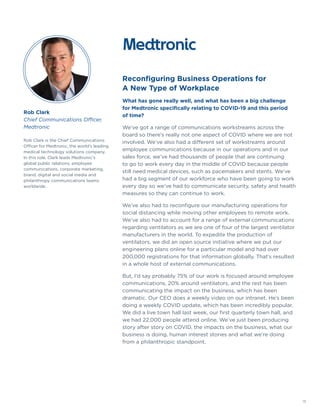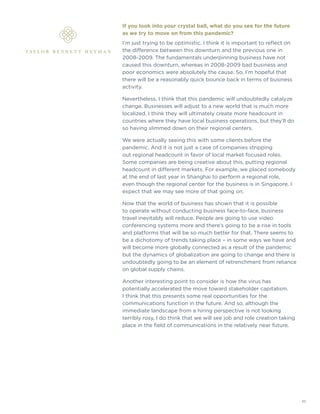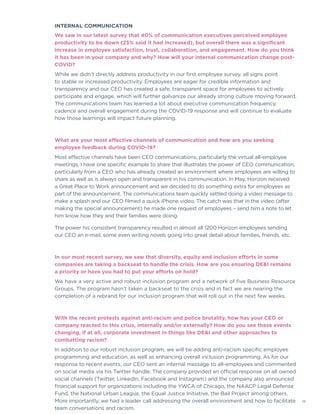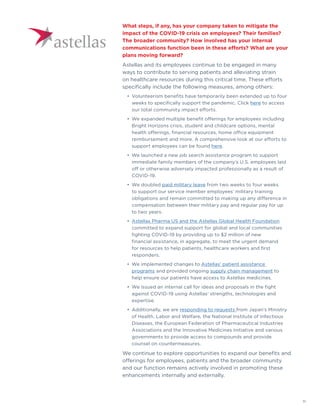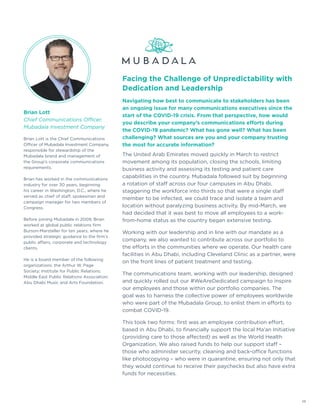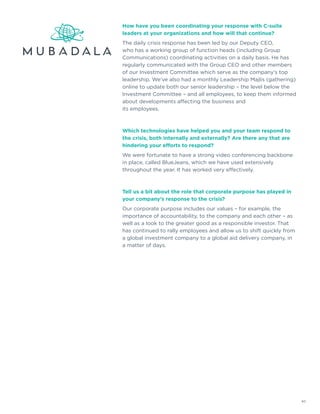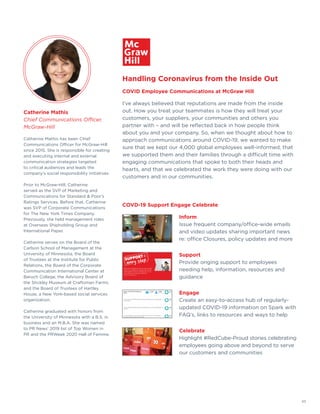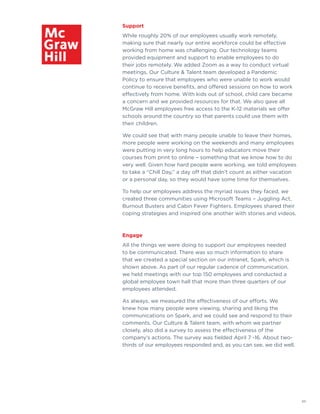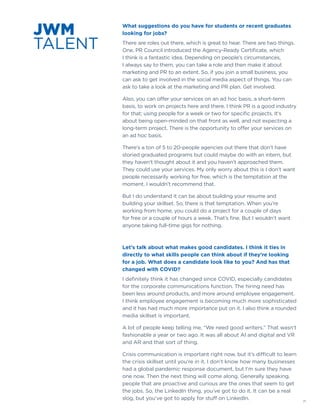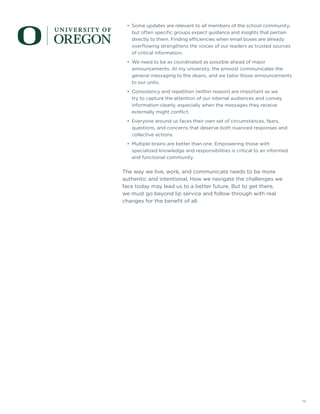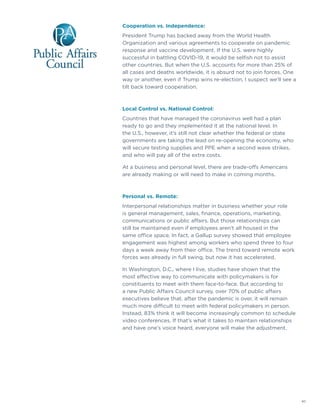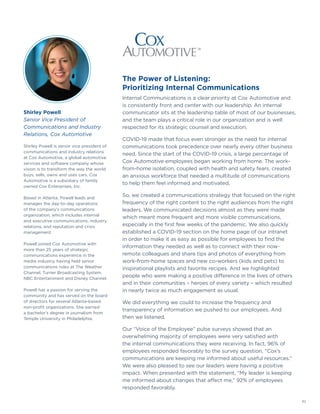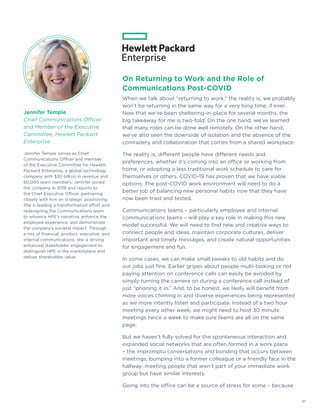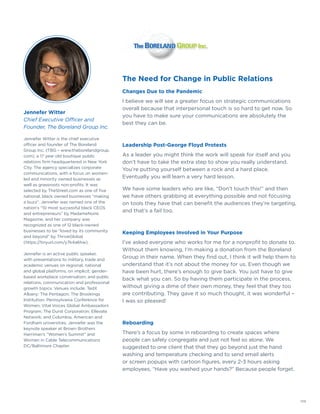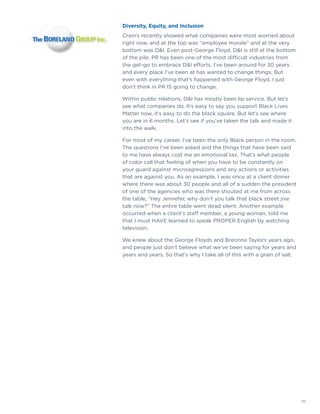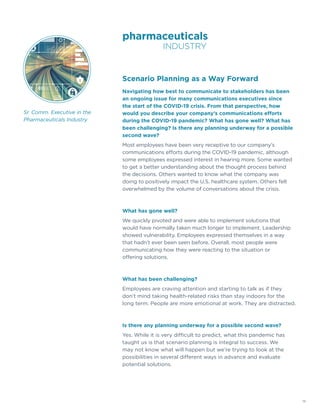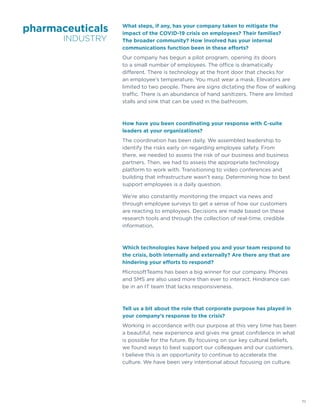Leadership Perspectives: Leading and Looking Ahead Through COVID-19
- 1. 1 Leadership Perspectives: Leading and Looking Ahead Through COVID-19 As COVID-19 continues to threaten the health of millions worldwide, it also continues to significantly impact businesses and has led many corporate leaders to shift their priorities. For some, this means focusing more on internal engagement; for others, it necessitates a refreshed look at mobile technologies and the role they will play in this “new normal.” Despite the challenges currently facing almost every company in the global marketplace, many top executives are also looking at the opportunities within the crisis, assessing the makeup of the workplace as well as recruitment and retention practices. This is even more crucial as the plague of systemic racism has become a focal point of public discourse, leading many organizations to revisit their corporate purpose and work to be part of the solution in this area. The Institute of Public Relations (IPR) and Peppercomm are proud to present their third joint study of 2020 on the effects of COVID-19 on businesses and how leaders are responding. While the first two reports provided important numerical findings on corporate preparedness and collaboration regarding the pandemic, this new report provides an in-depth analysis from 30 senior communications executives on how they are leading and looking ahead of this crisis. Interviewees represent various industries, including healthcare, manufacturing, retail and finance. “This is the third in a series of co- branded research reports that has shed light on the thoughts, feelings and actions of America’s most senior communications professionals as they help steer organizations through the uncharted waters of the COVID-19 pandemic. Our intent in publishing these reports is to share best practices from the best minds in the profession and help each and every one of us anticipate and prepare for the unknown.” – Dr. Tina McCorkindale, President and CEO of the Institute for Public Relations and Steve Cody, CEO and Founder, Peppercomm An e-book by the Institute for Public Relations and Peppercomm on how communication leaders are responding to the pandemic and other organizational challenges
- 2. 2 Finding Guidance in a Different Place Jenn Mauer, Merck.................................................................................. 67 Job Hunting During a Global Crisis: The Importance of Flexibility and Involvement Jamie McLaughlin, JWM Talent...........................................................69 University Communication When a Global Pandemic and Protests Against Systemic Racism Converge Juan-Carlos Molleda, Ph.D., University of Oregon.......................73 COVID-19: Navigating Uncertainty Dominic Pendry, Bed Bath Beyond...............................................76 It’s the End of the World as We Knew It Doug Pinkham, Public Affairs Council..............................................79 The Power of Listening: Prioritizing Internal Communications Shirley Powell, Cox Automotive..........................................................82 Using Corporate Purpose to Navigate a Pandemic Linda Rutherford, Southwest Airlines...............................................85 The Unique Challenges of University Communication During a Pandemic Michael Schoenfeld, Duke University............................................... 90 Communications, COVID-19 and Creators Respond Erin Streeter, National Association of Manufacturers.................93 Open Questions in a “Post”-COVID World Chris Talley, USAA....................................................................................95 On Returning to Work and the Role of Communications Post-COVID Jennifer Temple, Hewlett Packard Enterprise...............................97 Tackling Widespread Misinformation in the Age of COVID-19 Chuck Wallington, Cone Health........................................................100 Crisis: Pushing Communications to the Forefront Danielle Ward, Understood................................................................106 The Need for Change in Public Relations Jennefer Witter, The Boreland Group............................................109 Scenario Planning as a Way Forward Sr. Comm. Executive in the Pharmaceuticals Industry............... 111 Conclusion and Method........................................................................ 114 TABLE OF CONTENTS Shifting from External Promotion to Internal Engagement Barbara Bates, Hotwire......................................................... 3 Focusing on Transparent and Frequent Internal Communication Matt Bianco, Novelis............................................................... 5 Increased Collaboration: A Tool for Success Amid a Pandemic Jill Carapellotti, Macy’s.......................................................... 8 Reconfiguring Business Operations for a New Type of Workplace Rob Clark, Medtronic............................................................13 Opportunity in Crisis and a Changing Global Landscape Sarah Crawshaw, Taylor Bennett Heyman.....................17 In a Post-COVID World, Trust Will Be Paramount Geoff Curtis, Horizon Therapeutics.................................21 Toward a Digital, Mobile, Engaging and Measurable Future Ray Day, Stagwell..................................................................27 Staying Agile and Authentic in Response to Crisis Paul Gennaro, Voya Financial............................................32 In the Search for Truth, “Meaning” Matters Most Gary F. Grates, W2O Group...............................................38 “Staying Connected” to Employees and Community During COVID-19 Jon Harris, Conagra............................................................. 40 Crises Reveal Character Catherine Hernandez-Blades, Aflac................................45 The Rising Importance of Telemedicine and Digital Health Moyra Knight, Astellas.........................................................49 In Pursuit of the Good Company Mike Kuczkowski, Orangefiery........................................ 55 Facing the Challenge of Unpredictability with Dedication and Leadership Brian Lott, Mubadala............................................................58 Handling Coronavirus from the Inside Out Catherine Mathis, McGraw Hill..........................................63
- 3. 3 Barbara Bates Global CEO, Hotwire Barbara is the Global CEO of Hotwire and the former founder and CEO of Eastwick Communications – which was acquired by Hotwire in 2016. She has more than 25 years’ experience working with brands to tell their stories, accelerate growth and build value working in Silicon Valley and beyond. Barbara has partnered with some of the world’s biggest technology brands as well as emerging leaders to create high-impact communication strategies and was named in Business Insider’s 2014 list of 50 Best Public Relations People in Tech and one of the Top 5 Women in PR by the PR World Awards. More recently, she has been recognized as one of San Francisco Bay Times’ Most Influential Women In Bay Area Business, one of the winners of CEO Today’s Business Women of the Year, and a finalist in Silicon Valley’s Women in IT Awards Series. Shifting from External Promotion to Internal Engagement In response to the COVID-19 pandemic, few marketing priorities have proven they will remain as vital an asset as communications. From reporting accurate, global health information to supporting the maintenance of business continuity to adequately announcing new work-from-home (WFH), furlough and layoff policies, communications roles and priorities have played a vital role for clients and corporations over the past few months of upending change. For many in the marketing and communications industry, the biggest shift in our day to day work has been the pivot from supporting external promotion to internal engagement. In lieu of cancelled events and product launches, agencies with diversified offerings were the best prepared to make this remit change, shifting client resources to the greater, more urgent need. Corporate leaders are now directly facing the challenge of finding the best ways to be transparent, informative and authentic in communications to their employees in a time of great uncertainty. In the coming months, we will of course see the slow swing back to “normal” promotion and campaigns for many clients, but we believe this pandemic has shown the necessity of effective internal and crisis communications for an organization – and why these solutions should remain part of a company’s engagement strategy in the years to come. The complete adjustment to WFH policies has been a great example of this. Corporations have had to address (1) how to function at the same capacity with a disparate workforce, as well as (2) keep employees informed, engaged, on task and in touch with one another. These are incredibly difficult communications challenges in the best of times, but even more so when they are forced without preparation. In addition to finding the right communications tools – Slack, Microsoft Teams, Zoom, etc. – the companies that have fared the best as WFH policies continue into the summer are those that embraced the change as an adjustment of their company culture instead of creating a Band-Aid fix to maintain practices that were no longer effective when not working in the office. For example, at Hotwire, we have been building what we call a
- 4. 4 “thoughtful working” policy over the past few years. Meaning, we trust our employees to be the adults that they are: to be accountable and complete their work on time and well, but to do so where, when and how it makes the most sense for them. This mindset made the shift to completely working from home a much smoother transition than most companies, and allowed us to dedicate resources to improving the at- home experience (with scheduled meditations, healthy guidelines and weekly leadership video updates) instead of simply adjusting to it. If not already in place, agencies should be using this time to truly implement policies that support their own employees, and not simply recommend those policies to clients. Healthier, happier and more supported communications professionals will be able to weather this and future storms in a much more productive way. One aspect often overlooked but vitally important to supporting your employees as they work from home: a continued focus on diversity and inclusion initiatives. Often, this falls by the wayside when more “urgent” needs arise, but as we are reminded time and time again, DI considerations should be at the very center of employee policies and communications. Keep in mind that working from home may not necessarily be an equitable circumstance for many. Parents homeschooling young children, BlPOC facing renewed uncertainty in light of recent civil unrest and young workers in small, shared accommodations are all facing different challenges on a day-to-day basis. Not every situation is the same, so ensure the communication and implementation of new policies is as equitable as possible, keeping empathy at the core. Like a lot of leaders, I don’t know when we will finally return to the “new normal,” but I do anticipate that the communications industry has been permanently affected by the change. An emphasized focus on internal communications – for client crises, employee engagement and continued work practices – will remain a vital need for both corporations and agencies. PR agencies with diversified offerings and experience will be best prepared to weather the current crisis and support client priorities on the other side.
- 5. 5 Focusing on Transparent and Frequent Internal Communication Navigating how best to communicate to stakeholders has been an ongoing issue for many communications executives since the start of the COVID-19 crisis. From that perspective, how would you describe your company’s communications efforts during the COVID-19 pandemic? What has gone well? What has been challenging? What sources are you and your company trusting the most for accurate information? At Novelis, our communications efforts have been aimed at helping ensure employee safety and business continuity. To that end, we have significantly increased our communications with employees, customers and suppliers, establishing and maintaining new and innovative channels to keep stakeholders informed about the company’s actions and operations during this evolving pandemic. A majority of our actions – specifically around safety – have been informed by global government agencies and health authorities. What will the business world look like post COVID-19? What role will strategic communications play in shaping what the business world will look like? That’s a heck of a question. I think the business community has surprised itself with how well it can function virtually with people working from home. Productivity is up and people are able to take more intentional steps to achieve work-life balance, from spending more time with their kids and partners, to exercise, to finding new and innovative ways to connect with each other. And dogs love it! While many people (and all dogs!) are enjoying the ability to work from home, it is becoming increasingly evident that we need to do more around our culture to ensure we maintain a collective and collaborative workplace – albeit remotely. Matt Bianco Head of Corporate Public Affairs, Novelis, Inc. Matt Bianco is currently the Head of Corporate Public Affairs for Novelis, Inc. the world leader in aluminum rolling and recycling with 33 operations in 9 countries, and approximately 15,000 employees worldwide.
- 6. 6 What steps, if any, has your company taken to mitigate the impact of the COVID-19 crisis on employees? Their families? The broader community? How involved has your internal communications function been in these efforts? What are your plans moving forward? We have made every effort to keep our people employed – we believe that is the best way we can keep our families and communities safe. Novelis has also made targeted charitable contributions, as well as PPE, to help curb the spread of COVID-19 in our local communities and to provide aid to those who have been adversely impacted. These donations include in-kind and financial support to local hospitals, food banks, community health organizations, and school systems around the world. Communications has been instrumental in this work (CSR is a part of our function) and has made – and will continue to make – these types of recommendations moving forward. How have you been coordinating your response with C-suite leaders at your organizations and how will that continue? At Novelis, we activated our Global Crisis Team to ensure a coordinated and holistic approach across all Novelis regions and facilities to effectively respond to the evolving COVID-19 situation. The Team includes our CEO, CFO, Regional Presidents, Global Security, Environmental Health Safety, Legal and Communications personnel. This group has been meeting three times per week and will continue to meet for the foreseeable future. Which technologies have helped you and your team respond to the crisis, both internally and externally? Are there any that are hindering your efforts to respond? Like many companies, we have become very familiar and increasingly facile with virtual meeting technology solutions – you name the technology, we’re probably using it. Tell us a bit about the role that corporate purpose has played in your company’s response to the crisis? At Novelis, we are driven by our purpose of shaping a sustainable world together, and are committed to keeping our people and communities healthy and safe during these challenging times. From our charitable giving, to work-from- home flexibility, to using our aluminum to make cradles for ventilators, our purpose is at the heart of all we do.
- 7. 7 RETURN TO WORK How involved is this communication function in return-to-work preparation? What are you doing in terms of strategic communication planning for this “return to business?” What are some steps you’re taking to ensure your employees are being taken care of in terms of the physical office space and psychologically in terms of feeling safe? How are you going to RTW? Communications has been instrumental in return-to-work preparation. We have created and distributed an Employee Handbook to all employees with general and site-specific information to help ensure a smooth and safe transition back to the workplace. It includes resources and guidance, as well as FAQs to address top employee concerns. With stable operations in place and colleagues working effectively from home, we believe that a pragmatic, phased approach to returning to work will significantly reduce the risk for potential future infection and help keep our employees safe. Is there anything changing with how your company is focusing on remote work? Or any changes the communication function overall as a result of COVID-19? If so, what? Our company has embraced working remotely and is currently evaluating the implementation of a long-term Work from Home policy. As a global Communications function, we are now speaking more regularly as a team – given the critical need for message alignment across regions during COVID-19. INTERNAL COMMUNICATION We saw in our latest survey that 40% of communication executives perceived employee productivity to be down (25% said it had increased), but overall there was a significant increase in employee satisfaction, trust, collaboration, and engagement. How do you think it has been in your company and why? How will your internal communication change post-COVID? We do not see a lack of productivity at all. In fact, we see people spending too much time online and are encouraging colleagues to “step away from the computer.” What are your most effective channels of communication and how are you seeking employee feedback during COVID-19? The most effective channels have been virtual CEO town halls and day-to-day email communications – given how quickly things evolve. Employees are appreciative of the increased cadence of communications as well as the transparency of those communications. There are a lot of difficult topics to discuss!
- 8. 8 Increased Collaboration: A Tool for Success Amid a Pandemic Navigating how best to communicate to stakeholders has been an ongoing issue for many communications executives since the start of the COVID-19 crisis. From that perspective, how would you describe your company’s communications efforts during the COVID-19 pandemic? What has gone well? What has been challenging? What sources are you and your company trusting the most for accurate information? Macy’s is dedicated to keeping our colleagues, customers and communities informed, from the policies in place to keep them safe as our stores reopen, to ensuring our colleagues have the resources and information necessary for their wellbeing. As we have furloughed team members across the country, we have worked to keep these valued colleagues updated on the business, but also in the loop on key initiatives that impact them, such as benefits open enrollment and the company’s support of equality in the face of national civil unrest. Some challenges we have encountered are around keeping our furloughed colleagues engaged. We are also working through the challenges of keeping up with the speed of change and having fewer team members to get the job done. We continue to look to government agencies, such as the Center of Disease Control (CDC) for accurate and up-to-date information related to COVID-19. What will the business world look like post COVID-19? What role will strategic communications play in shaping what the business world will look like? The communications role at Macy’s will broaden as we move into the future. We will continue to cultivate a strong voice in response to the needs of our colleagues and customers. Our communications team is not just managing how we talk about what we’re doing, but we are also at the table to support the work of policy making, crisis management and business resiliency. Jill Carapellotti Group Vice President, Corporate Communications, Macy’s Inc. Jill Carapellotti is Group Vice President, Corporate Communications for Macy’s Inc. She has two decades of global strategic communications experience with specialization in corporate communications, internal communications, change and issues management, executive coaching and corporate branding. She held positions and managed projects within the full spectrum of corporate communications including: internal communications, external communications, media relations, corporate giving, video and graphic production, CSR, issues and crisis management. She has worked within multiple disciplines, including automotive, beauty, consumer goods, education, entertainment, fashion, finance, healthcare, hospitality, information systems, real estate, retail, technology, and telecommunications. She is an active member of New York Women in Communications, International Association of Business Communicators, and a Trustee for the Institute for Public Relations.
- 9. 9 What steps, if any, has your company taken to mitigate the impact of the COVID-19 crisis on employees? Their families? The broader community? How involved has your internal communications function been in these efforts? What are your plans moving forward? The safety and wellbeing of our colleagues, customers and communities is a top priority. Communications has been closely partnered on all efforts to ensure we are doing what is best for our colleagues and the communities we serve. We’ve implemented safety and wellness practices in our stores, call centers and distribution facilities, including hand sanitizers, temperature checks and plexi glass partitions. We’ve also addressed the emotional toll the pandemic has had on our colleagues, encouraging those eligible to utilize personal time off, practice work life balance and seek support through our Employee Assistance Program, which provides resources and counseling at no additional cost to our colleagues. How have you been coordinating your response with C-suite leaders at your organizations and how will that continue? Collectively, we are all in the trenches, and our C-suite leaders are together with us on the front lines to help make decisions and drive change. Which technologies have helped you and your team respond to the crisis, both internally and externally? Are there any that are hindering your efforts to respond? We’ve leveraged existing technology and our intranet sites to reach our colleagues, as well as email and text message when appropriate. We’ve also embraced virtual platforms to bring our teams together, including Microsoft Teams for webcasts and collaborative meetings. While sheltering-in-place has kept our teams separated, our communications efforts are allowing us to stay closer than ever before. Tell us a bit about the role that corporate purpose has played in your company’s response to the crisis? At Macy’s, giving back is in our DNA. We’ve supported our local communities in many ways, including raising over $1 million dollars for the Meals on Wheels COVID-19 Response Fund, providing 100,000 meals and check-ins for vulnerable seniors. Additionally, some of our office locations have donated perishables to local shelters and food banks while our teams work remotely. In some store locations, our parking lots have held graduation ceremonies for local high schools, enabling seniors to walk across the stage and receive their diplomas with their extended family viewing live from their cars and listening on an FM channel.
- 10. 10 RETURN TO WORK How involved is this communication function in return-to-work preparation? What are you doing in terms of strategic communication planning for this “return to business?” What are some steps you’re taking to ensure your employees are being taken care of in terms of the physical office space and psychologically in terms of feeling safe? How are you going to RTW? Communications is closely involved with the teams establishing our return-to-office plan, and we’ve seen great efficiency and collaboration across teams virtually. We’ve given careful thought to how we will approach the return to our offices. We will take all the necessary precautions for the safety of our colleagues. The return to offices will be a slow and measured process with all decisions made carefully based on conditions in the community, government and health guidelines, and readiness of the office environment. At this time, we do not plan to fully reopen our corporate offices until, at least, September 2020. Our teams are diverse with a variety of roles, needs and specific space requirements that need to be considered. As a result, we’ve identified three types of role classifications that we will use to build our plan to return to the office: highly dependent on the office; somewhat dependent; or not at all dependent. At the right time and when it is safe, colleagues will return based on these classifications. Is there anything changing with how your company is focusing on remote work? Or any changes the communication function overall as a result of COVID-19? If so, what? This pandemic has re-shaped how we think about remote work, shifted our view about the importance of an office environment and taught us about flexibility. We have learned how to adapt and be efficient without being together physically. We have remained connected, building relationships and achieving camaraderie despite the distance. Most importantly, we have experienced a significant increase in collaboration and speed of decision-making that has been vital not only to our culture but to our business strategy. So, now is the right time to re-frame our mindset about how we work. The role of the office will remain important, but it may not play as much of a central role as it has in the past – at least in the near-term. Getting our work done is the primary focus, regardless of where that work physically takes place. As a company, we will embrace a virtual and flexible work approach that is more advanced than our policies in the past.
- 11. 11 INTERNAL COMMUNICATION We saw in our latest survey that 40% of communication executives perceived employee productivity to be down (25% said it had increased), but overall there was a significant increase in employee satisfaction, trust, collaboration, and engagement. How do you think it has been in your company and why? How will your internal communication change post-COVID? To understand what we’ve learned and how we’ve used communications during this pandemic, we must first talk about the makeup of our colleague population. Macy’s, like any brick and mortar retailer, is an in-person business when it comes to our stores. The majority of our 125,000 colleagues work in our stores and, when all locations are safe to re-open, we look forward to continuing to serve our customers in-person. Our store colleagues are working efficiently with our enhanced safety procedures and, in the process, have figured out new ways of working to provide the best experience for our customers, including curbside pick-up, which was implemented quickly and has been a well-received option for our customers. Our distribution centers have been running our fulfillment efforts for our digital and store replenishment and have been working efficiently through this pandemic to serve the needs of our business. This team has led the way in enhanced safety procedures that we’re using throughout the organization. Our corporate colleagues who support these teams in Marketing, Digital, Merchandising, Finance, HR, Legal, Communications, etc., have primarily worked remotely through this pandemic. The shift from office environment to remote workplace happened basically overnight and shifted how we work, collaborate, communicate and engage. We discovered that we became highly productive in this new environment. Our virtual meetings start on time, everyone is prepared, and, to foster connectivity and engagement, we have a culture of keeping cameras on, which includes seeing work and personal lives come together. What are your most effective channels of communication and how are you seeking employee feedback during COVID-19? Within all colleague groups, we’ve learned a lot about how to get the work done through this pandemic, using formal and informal communication as a powerful connection point. We use internal communications constantly to update our colleagues on operational information, and use weekly CEO updates, webcasts and virtual town halls, to drive our culture and to keep colleagues informed. Our internal messages are also shared externally on LinkedIn, from both our CEO’s and company’s profile. We also encourage our managers (who we call People Leaders) to check on their teams regularly, set up scheduled check-ins and open their virtual doors for those impromptu conversations that matter the most. We need to be good listeners, lead with empathy and care for the colleague beyond the work. This approach is already intuitive to who we are and has served us well through these challenging times. In our most recent survey, we saw that diversity, equity and inclusion efforts in some companies are taking a backseat to handle the crisis. How are you ensuring DEI remains a priority or have you had to put your efforts on hold? Our colleagues are as richly diverse as the communities we serve and DEI efforts remain a priority. As we continue to look to the future, our strategy to drive DEI is integrated into the work we need to accomplish. We expect our colleagues to hold us accountable to the goals and commitments that we have made to prioritize DEI. The pandemic does not change our ultimate pledge to promote diversity and inclusion at Macy’s and respect everyone who walks through our doors.
- 12. 12 INTERNAL COMMUNICATION (CONT.) Additional comments? Anything we may have missed? We worry about the burnout caused from virtual work in the current environment. It’s so important to foster downtime and separate work from personal, when many of our colleagues are doing both in the same space. It would be helpful to learn how other companies are creating this balance with their virtual workforce. With the recent protests against anti-racism and police brutality, how has your CEO or company reacted to this crisis, internally and/or externally? How do you see these events changing, if at all, corporate investment in things like DEI and other approaches to combatting racism? At Macy’s, we embed DEI into how we think, act and operate. Our commitment to DEI has been a priority for years and it’s an investment in the work we continue to do every day. Our Chairman and CEO has addressed the company’s support of racial equality externally on social media and in an open email to customers. We’ve also committed $1 million to our social justice partners to combat social and racial injustice, including National Urban League and National Action Network. For our internal colleagues, our CEO hosted a “Can We Talk?” session with Dr. John Fitzgerald Gates, Vice Provost for Diversity and Inclusion at Purdue University. This session invited all Macy’s, Inc. colleagues (regardless of furlough status) to attend and listen to an open conversation about systemic racism inherent in the recent acts of racial injustice. As a follow up, we held a series of smaller discussions with colleagues to continue to listen and better understand how we ensure Macy’s, Inc. has a culture where every colleague is seen, is safe, and has the opportunity to reach their full potential. Colleagues were encouraged to participate in a period of silence for George Floyd, his family, and other black lives that have been lost, pausing for eight minutes and 46 seconds in silent reflection. Anti-racism and allyship resources have been provided to all colleagues for further education. People Leaders are conducting open and candid conversations with their teams and creating safe, supportive environments that foster compassion and empathy. As America’s Department Store, we remain committed to DEI and cultivating a workforce that is as diverse as the communities we serve. We still have work to do. On our agenda is to attract and retain top multicultural talent, both by developing the potential of our internal talent, and through our external recruitment efforts. Our goal is to have 30% of VP and above roles held by minority talent by 2025. We continue to listen and learn from our colleagues, and while we cannot always control what happens outside of our stores and facilities, we can shape the culture within. And that is one of inclusion that welcomes and respects all, believing and acting on the principle that all of us are created equal.
- 13. 13 Rob Clark Chief Communications Officer, Medtronic Rob Clark is the Chief Communications Officer for Medtronic, the world’s leading medical technology solutions company. In this role, Clark leads Medtronic’s global public relations, employee communications, corporate marketing, brand, digital and social media and philanthropy communications teams worldwide. Reconfiguring Business Operations for A New Type of Workplace What has gone really well, and what has been a big challenge for Medtronic specifically relating to COVID-19 and this period of time? We’ve got a range of communications workstreams across the board so there’s really not one aspect of COVID where we are not involved. We’ve also had a different set of workstreams around employee communications because in our operations and in our sales force, we’ve had thousands of people that are continuing to go to work every day in the middle of COVID because people still need medical devices, such as pacemakers and stents. We’ve had a big segment of our workforce who have been going to work every day so we’ve had to communicate security, safety and health measures so they can continue to work. We’ve also had to reconfigure our manufacturing operations for social distancing while moving other employees to remote work. We’ve also had to account for a range of external communications regarding ventilators as we are one of four of the largest ventilator manufacturers in the world. To expedite the production of ventilators, we did an open source initiative where we put our engineering plans online for a particular model and had over 200,000 registrations for that information globally. That’s resulted in a whole host of external communications. But, I’d say probably 75% of our work is focused around employee communications, 20% around ventilators, and the rest has been communicating the impact on the business, which has been dramatic. Our CEO does a weekly video on our intranet. He’s been doing a weekly COVID update, which has been incredibly popular. We did a live town hall last week, our first quarterly town hall, and we had 22,000 people attend online. We’ve just been producing story after story on COVID, the impacts on the business, what our business is doing, human interest stories and what we’re doing from a philanthropic standpoint.
- 14. 14 What have been some of the challenges with that? We’ve always struggled a little bit with communications into our manufacturing operations because they’re not as digitally connected. They mostly get information through word of mouth from their frontline leader. We’ve had to do a lot of work to get the right messages to them and respond to their needs, to keep people motivated, and to assure them that we’re doing everything we can to make them safe in the workplace, particularly in some areas in the world where our operation facilities are in virus hotspots. So, it’s been an ongoing challenge to get the right information to people. We’ve also added additional health care services for our employees in those countries. Getting those services set up, communicated, and getting people enrolled and participating has been probably the biggest challenge from an employee communications perspective. We have more than 40,000 people in an operations environment around the world. How are you ensuring DEI initiatives are continuing or still embedded throughout? It’s been one of our top five corporate issues for the last ten years; it didn’t go away. The biggest casualty for us was that we won the Catalyst Award, which is one of the preeminent corporate inclusion and diversity awards in the country, but the date of the award celebration fell on one of the first weeks where COVID was coming down, so they had to cancel. It was in New York City. It was a bummer that we couldn’t celebrate that recognition, because that’s a major accomplishment. But, it hasn’t stopped our fundamental momentum. Every time we do a town hall, there is a focus on inclusion and diversity. It’s in our top five goals for typically every VP. Nothing there has stopped.
- 15. 15 How do you see DEI efforts generally changing in the future? Especially because you’re in Minneapolis, you have a very interesting viewpoint on that. Do you want to talk about that and how Medtronic has reacted? I think the corporations here are at a bit of a loss of words right now, other than we all recognize that the fundamental issues with race and bigotry are unacceptable and have to be rooted out. In terms of what to do next, we’ll invest in business redevelopment, and things like that. But clearly, there’s something much deeper here. I think the frustration is that this community and our community partners have tried so hard, and yet we still do have the largest wealth disparity in the country. We have the biggest achievement gap in the country. There’s a huge dichotomy in this community. The wealth disparity between African Americans and the rest of Minnesota has always been an issue. We have not solved it. Clearly what we’ve been doing is not working. I think what we’re doing at Medtronic is a little bit of the back to the drawing board. We are thinking, with our assets and resources and expertise, what’s our contribution towards solving the underlying problem? What do you think has changed in the comms function post- COVID? I know we’re not through COVID. But what do you see as potential permanent changes? Because you’ve talked a lot about internal comms, do you think there will be more emphasis on it? We were in the middle of a big intranet transition and it’s importance has been magnified exponentially. Part of the reason we did it was to take on more of a real-time news feel. It’s an accumulation of stories almost in real-time, stories about what’s going on within the company and our employees have gravitated there heavily during the pandemic. The biggest issue we’ve had is being able to have enough people and resources to keep up at the pace that people are wanting information. How do we sustain that? I don’t have 15 journalists walking around here that can produce news and updates constantly so sustaining the volume and timeliness has been the challenge.
- 16. 16 Any other changes that you think may be more permanent in communications moving forward? Generally, you want your comms people located together physically, but the reality is, we’ve all worked incredibly well remotely. So, remote work is here to stay in some form going forward. I think that, like everybody else, we’ve been struggling with inclusion and diversity, and bringing in a diverse talent mix. I think a little bit of the problem is we’re trying to get diverse talent to relocate to certain locations that aren’t as diverse or where people may not want to live. I think we’ll do a lot more remote work and have less of a perspective of where that work has to be situated. We have locations all over the country if people need a location to tether to. It sounds like you’ve been coordinating quite a bit with a lot of other C-suite leaders in the organization; how has the response to that been? We have a COVID Crisis Response Team. We meet daily. We have an executive committee meeting each week with our communications report out there. We’ve had multiple report outs to our Board. It’s a full-court press of our key human resources, operations, government affairs, communications, and legal teams. How are you prepping for employees to return to the corporate office? We’ve had a sub-team of the crisis team working specifically on the return to office. We completed our return to office toolkits for our facilities a couple of weeks ago, and now we’re in the process of getting authorization for the return to work at a site by site level. Social distancing, PPE, and so forth has to be in place before they’re given a green light to go back and we have around 160 locations around the world. We’ve only had three that have gone back to work so far.
- 17. 17 Sarah Crawshaw Managing Director, Asia Pacific, Taylor Bennett Heyman Sarah Crawshaw is the Managing Director, Asia Pacific at Taylor Bennett Heyman. She consults clients across all industries and works closely with communications and corporate affairs professionals to help them navigate and build their careers. Sarah has considerable experience in communications search and has provided talent management solutions to many leading listed companies in markets across the Asia Pacific region. She also consults with businesses on organizational design and competency framework development. Sarah sits on the Institute for Public Relations’ Board of Trustees. She is also an active member of the International Association of Business Communicators, as well as Page Up, the Arthur W. Page Society’s membership organization for tomorrow’s CCOs. Prior to her career in Asia, Sarah worked in executive search for Taylor Bennett in London, again specializing in communications, with a focus on UK public affairs and investor relations assignments. She holds a Master’s in Economics and Politics from the University of Edinburgh and a Bachelor of Laws from the BPP Law School, London. Opportunity in Crisis and A Changing Global Landscape How has the pandemic affected companies being able to hire senior executives in Asia? Surprisingly in Hong Kong, we haven’t been affected as much by COVID-19 as many other parts of the world. Business is certainly down, but we’ve taken on new business and placed people during this period, and they’ve joined their respective organizations, even going into the office because we haven’t ever been in full- blown lockdown. But, inevitably, in a lot of markets the onboarding process will be impacted and delayed. What do you consider to be the opportunities for communications to demonstrate business value during the pandemic? I think there has been an opportunity for communications to shine during this period by working more closely with product development teams; providing input to these teams as to what consumers, clients and society want and need during this time. Communications teams act as the window to the outside world for businesses, which gives them an opportunity to help in the creation of solutions for this environment; solutions and products that could ultimately help to enhance a business’ reputation. I don’t know whether communication professionals have been doing that, but I think that’s a key opportunity. And we’ve certainly seen a number of job openings in marketing communications during this period. Another area that communicators will be having to really flex their muscles right now is media engagement and gaining share of voice. A lot of the media reporting is focused on the pandemic, meanwhile people are suffering from (social) media saturation as a result of relying wholly on social media channels to interact with people during the pandemic. One potential consequence of these dynamics is people switching-off from the media due to saturation. Which means that communications teams will be having to work even harder to tell their businesses’ stories. Certain communications agencies in Asia are clearly doing well out of this situation, particularly the ones that help in terms of crisis and business continuity. They are helpful in providing companies with an external perspective and objective guidance to manage
- 18. 18 the scenario. Plus, organizations don’t want to invest in permanent headcount at the moment. Most businesses are only fulfilling a select few strategic appointments right now. Everything else is on hold. Agencies can profit from this because they can help to fill gaps, without placing the same pressure on budgets as permanent headcount otherwise would. In your market, how prevalent is the integration of marketing and communication? Do potential executive hires have experience in both product and communications? We have observed certain businesses, within certain industries, showing a desire to integrate marketing and communications. But people tend to have experience and skills in one or the other. Over the course of the last five years or so, we’ve seen people trying to gain experience in both marketing and communications, recognizing that this is the direction that a lot of businesses may go in, particularly in markets like China. Almost every communications professional that I speak to in China wants to gain experience in marketing. What other dynamics and trends are you seeing in terms of hiring in the field of communications? An area where we are seeing an investment in hiring - which started before the pandemic and will likely continue – is, public policy and government relations. This virus has accelerated these dynamics. Businesses are going to need people with that expertise. That’s where we’re envisaging most opportunity in the next year to two years, frankly, and it’s across the board in Asia. Another dynamic is the reduced emphasis on regional headcount and an increased emphasis on people with deep market expertise and a localization of expertise. I think that’s going to be accelerated by COVID-19, primarily because this is a region where businesses have often relied on people being able to hop between markets. I mean, we’re a case in point as a business; we have a regional center and we service six or seven markets from Hong Kong, but it relies on us being able to go to those markets. That’s impossible in this environment, for starters. Secondly, you’ve got the rise in nationalism and increasing concerns about whether globalization has gone too far. Businesses are now looking at supply chain risks, realizing that they’re too reliant on the globalization dynamic, but they’re not necessarily going to pull out of those countries where they’ve got strong revenue streams like China. They’re going to have to localize more, I suspect, and bring in more local expertise that can play well into their international headquarters. I think that’s where we’re going to see a bigger shift. We were seeing it already in the hiring that we do. A big
- 19. 19 proportion of our work is country specific senior roles. I think we’ll see a stronger emphasis on that and it will continue to increase. Public policy and government relations are heavily reliant on local market expertise and that’s partly why I think we will see more opportunity in that space. Plus, the geopolitical dynamic means that public policy and government relations expertise are a necessity for a lot of businesses. What differences are you seeing from the 2008-2009 financial crisis and today? It’s a big contrast between this situation and what we saw in 2008- 2009. Clearly, the dynamics are completely different because the cause is completely different. In the 2008 financial crisis, what we saw was a huge surge in business from financial services organizations. They were looking for quality communications professionals to help (re)build reputation. We are not going to see that as a result of this downturn. This is a very different beast. It will not be overcome with reputation recovery for organizations because that’s not what sits at the heart of it. And therefore, unfortunately, what we have seen quite a bit at the moment is people leaving posts and businesses choosing not to refill that post, and instead, look at that function and say, “Okay. Who have we got in our business who could probably plug and play and do that as well?” And we’ve spoken to a few organizations who have done exactly that; they’ve said, “ We’ve got somebody who does our marketing communications, so let’s just give them the communications to manage too.” I would hope it’s a temporary thing. The reality is, businesses are trying to work out what they’re facing here, and many people don’t have a living memory of when economies have just ground to a halt for months. What we tend to see from businesses in economic downturns is a sort of internal reflection of capability capacity. They’re asking, what do we actually need? So, we’re going to see a fallout as businesses start to reflect on whether they’ve become a bit too heavy in areas that are not necessary. Once that clear out has happened, what normally happens is a further reflection and realization that “we do have a gap here and we do need to fill it.” I think that the government bailout packages will probably prolong that process. Whereas in previous downturns, that process has happened in a certain timeframe. I think the timeframe will be longer this time around because the packages are designed to help stem layoffs; the terms of these bail-out packages will therefore discourage companies from conducting any immediate restructuring exercises. So, in that sense, I think the recovery of the recruitment market will be quite slow.
- 20. 20 If you look into your crystal ball, what do you see for the future as we try to move on from this pandemic? I’m just trying to be optimistic. I think it is important to reflect on the difference between this downturn and the previous one in 2008-2009. The fundamentals underpinning business have not caused this downturn, whereas in 2008-2009 bad business and poor economics were absolutely the cause. So, I’m hopeful that there will be a reasonably quick bounce back in terms of business activity. Nevertheless, I think that this pandemic will undoubtedly catalyze change. Businesses will adjust to a new world that is much more localized. I think they will ultimately create more headcount in countries where they have local business operations, but they’ll do so having slimmed down on their regional centers. We were actually seeing this with some clients before the pandemic. And it is not just a case of companies stripping out regional headcount in favor of local market focused roles. Some companies are being creative about this, putting regional headcount in different markets. For example, we placed somebody at the end of last year in Shanghai to perform a regional role, even though the regional center for the business is in Singapore. I expect that we may see more of that going on. Now that the world of business has shown that it is possible to operate without conducting business face-to-face, business travel inevitably will reduce. People are going to use video conferencing systems more and there’s going to be a rise in tools and platforms that will be so much better for that. There seems to be a dichotomy of trends taking place – in some ways we have and will become more globally connected as a result of the pandemic but the dynamics of globalization are going to change and there is undoubtedly going to be an element of retrenchment from reliance on global supply chains. Another interesting point to consider is how the virus has potentially accelerated the move toward stakeholder capitalism. I think that this presents some real opportunities for the communications function in the future. And so, although the immediate landscape from a hiring perspective is not looking terribly rosy, I do think that we will see job and role creation taking place in the field of communications in the relatively near future.
- 21. 21 Geoff Curtis Executive Vice President, Corporate Affairs and Chief Communications Officer, Horizon Therapeutics Geoff Curtis is executive vice president, corporate affairs and chief communications officer at Horizon Therapeutics, overseeing corporate and brand communications, government affairs, patient advocacy and corporate social responsibility, sustainability and impact. He has more than two decades of health communications experience and has held roles on the agency and client side. In a Post-COVID World, Trust Will Be Paramount Navigating how best to communicate to stakeholders has been an ongoing issue for many communications executives since the start of the COVID-19 crisis. From that perspective, how would you describe your company’s communications efforts during the COVID-19 pandemic? What has gone well? What has been challenging? What sources are you and your company trusting the most for accurate information? Transparency and accountability are two of our core values and that is how we’ve centered our communications approach during the crisis. Even during a disruptive time, we are value focused, which makes it more business as usual from a communications standpoint than disruptive. Sure, some of the mechanisms and cadence may change, but the alignment to these values does not change. For us, we don’t have a scorecard on “what has gone well” or “what has been challenging” because we are always transparent with and accountable to our internal and external stakeholders. Although our intention hasn’t changed, where we have focused and learned is with cadence and message clarity since this is a different situation and there is a greater demand for information and guidance. Some of what we learned will be considered as we move into our return to office/field communications. As for COVID-specific sources, we rely on the CDC, WHO, as well as state departments of health and country-specific health authorities for up-to-date information and guidance. With a large sales force, we are relying heavily on state level guidance to determine a safe reentry into the field.
- 22. 22 What will the business world look like post COVID-19? What role will strategic communications play in shaping what the business world will look like? While it’s hard to predict the depth of the impact on the business world overall, one thing we all will agree on is that the pre- COVID office as we knew it will no longer exist. We can expect more remote work moving forward and those companies that will transition back into an office will likely do so in a staggered and limited capacity. Speaking for Horizon specifically, we have always had a flexible work policy with the ability to work remotely on a regular basis, so this coupled with what we have experienced during COVID-19 will not be a significant adjustment for employees. In addition, a large segment of our employee population (sales force) is remote, so there will not be any significant change as it relates to an office environment. In the post-COVID world, communicators will need to increase their focus on: 1) CEO/C-suite visibility particularly with internal stakeholders, 2) information flow/cadence/transparency and 3) information quality and tone. Trust will be paramount and it will be up to the communicators to instill that trust with internal and external stakeholders. What steps, if any, has your company taken to mitigate the impact of the COVID-19 crisis on employees? Their families? The broader community? How involved has your internal communications function been in these efforts? What are your plans moving forward? The overall employee response was a massive coordination between internal comms and human resources – not just on the rollout of the COVID-specific benefits, but also on all of the overall messaging used to answer pressing employee questions and develop surveys to test how employees are feeling. The communications function helped to make sure employees feel supported and know they are in safe, good hands. Overall, our internal communications played an integral role, in partnership with our human resources organization, in the messaging and as well as guiding people toward the current benefits that exist. From a pure tactical, HR benefits standpoint, we instituted a COVID-19 Leave Policy, which offers two weeks paid leave for recovery for an employee or his or her family member; 12 weeks of paid leave for severe COVID-19 cases for an employee or family member; policy also offers 12 weeks of paid leave for our medical professionals to volunteer or be called upon for their services. In addition, our existing wellness benefits include MD Live, a service for employees feeling ill to virtually connect with a physician; an Employee Assistance Program which provides professional
- 23. 23 support and guidance on a range of topics related to family, work, money and health; and Headspace, an app that each employee has a membership to, offering meditations and sleep aids, which all proved and continue to be particularly useful during the pandemic. Additionally, the internal communications function developed a COVID-19 specific intranet page, which served as the “source of truth” for Horizon-focused support and information along with feature articles on how to work remotely, and stay healthy, connected and engaged. For parents, we created a distinct community on our intranet that included helpful resources and activities to do with kids. How have you been coordinating your response with C-suite leaders at your organizations and how will that continue? We have been very deliberate with C-suite communication, particularly with our CEO, from a cadence and message standpoint. Typically, we have CEO-led, quarterly all-employee meetings supplemented with e-mail milestone-driven e-mail communication. In addition, our human resources colleagues historically hold monthly leader calls. During the COVID-19 crisis, we adjusted the cadence for the CEO all-employee meetings and e-mail communications to bi-monthly so that employees were hearing from him every week. The leader calls moved to once-weekly so that company leaders were hearing from other C-suite executives and the human resources team with increased frequency. The CEO-led, all-employee meetings have been surprisingly successful and well attended. We have consistently had 98+ percent of our employee base attend. The key learning for the communications team has been the structure of the meeting itself – focus the meeting on only QA and less on prepared remarks/ updates. We quickly found that employees want to be informed, feel secure and trust leadership. Our CEO would spend the majority of the calls answering 50-60 questions from employees. As a result, he created a space where employees wanted to participate and be transparent about how they were feeling. We have always had an open and transparent dialogue during our all-employee meetings, but spending a significant amount of time answering employee questions is something we will likely implement moving forward.
- 24. 24 Which technologies have helped you and your team respond to the crisis, both internally and externally? Are there any that are hindering your efforts to respond? There isn’t anything that is hindering our ability to respond. Internally, we have relied heavily on our intranet, e-mail, video and virtual meetings (Cisco). Externally, we have relied primarily on our owned social channels. Tell us a bit about the role that corporate purpose has played in your company’s response to the crisis? At Horizon, we believe it is our fundamental responsibility to support the communities where we live and work, as well as our global community. As a result, we felt strongly that it was our responsibility to step up during the COVID-19 crisis. We donated $1.5 million to COVID-19 response efforts in Illinois and in other impacted communities where our employees live and work, including Washington, D.C., South San Francisco, Canada, and Dublin, Ireland. In addition, we are matching employee donations to nonprofits in their communities, including local foodbanks and COVID-19 relief funds and also provided a list of digital volunteering opportunities and suggestions to employees, such as ordering from a local restaurant and having it delivered to a local domestic violence shelter.
- 25. 25 How involved is this communication function in return-to-work preparation? What are you doing in terms of strategic communication planning for this “return to business?” What are some steps you’re taking to ensure your employees are being taken care of in terms of the physical office space and psychologically in terms of feeling safe? How are you going to RTW? Our engagement and involvement are consistent with our approach to the COVID-19 crisis – we are playing an integral role, in partnership with our human resources organization, in the messaging and rollout of the return-to-work guidance. We are in a unique position as we are moving into a new location at the end of the year, which ultimately factors into our approach to returning to work – both from a standard and a change-management communications standpoint. From a physical office space standpoint, we, similar to other companies will likely stagger the employee return and limit the capacity in our current office space. We have provided all office- and field-based employees with Personal Protective Equipment and we are preparing socially distanced office configurations. In addition, we have the capability to check temperatures and are following other global health authority and individual state guidance for a safe return. Is there anything changing with how your company is focusing on remote work? Or any changes the communication function overall as a result of COVID-19? If so, what? We have always had a flexible work policy with the ability to work remotely on a regular basis, so this coupled with what we have experienced during COVID-19 will not be a significant adjustment for employees. In addition, a large segment of our employee population (sales force) is remote, so there will not be any significant change as it relates to an office environment. There are no changes planned in the communications function other than taking the learnings around the need for increased cadence and clarity and applying those to the return to work communications. RETURN TO WORK
- 26. 26 We saw in our latest survey that 40% of communication executives perceived employee productivity to be down (25% said it had increased), but overall there was a significant increase in employee satisfaction, trust, collaboration, and engagement. How do you think it has been in your company and why? How will your internal communication change post- COVID? While we didn’t directly address productivity in our first employee survey, all signs point to stable or increased productivity. Employees are eager for credible information and transparency and our CEO has created a safe, transparent space for employees to actively participate and engage, which will further galvanize our already strong culture moving forward. The communications team has learned a lot about executive communication frequency, cadence and overall engagement during the COVID-19 response and will continue to evaluate how those learnings will impact future planning. What are your most effective channels of communication and how are you seeking employee feedback during COVID-19? Most effective channels have been CEO communications, particularly the virtual all-employee meetings. I have one specific example to share that illustrates the power of CEO communication, particularly from a CEO who has already created an environment where employees are willing to share as well as is always open and transparent in his communication. In May, Horizon received a Great Place to Work announcement and we decided to do something extra for employees as part of the announcement. The communications team quickly settled doing a video message to make a splash and our CEO filmed a quick iPhone video. The catch was that in the video (after making the special announcement) he made one request of employees – send him a note to let him know how they and their families were doing. The power his consistent transparency resulted in almost all 1200 Horizon employees sending our CEO an e-mail, some even writing novels going into great detail about families, friends, etc. In our most recent survey, we saw that diversity, equity and inclusion efforts in some companies are taking a backseat to handle the crisis. How are you ensuring DEI remains a priority or have you had to put your efforts on hold? We have a very active and robust inclusion program and a network of five Business Resource Groups. The program hasn’t taken a backseat to the crisis and in fact we are nearing the completion of a rebrand for our inclusion program that will roll out in the next few weeks. With the recent protests against anti-racism and police brutality, how has your CEO or company reacted to this crisis, internally and/or externally? How do you see these events changing, if at all, corporate investment in things like DEI and other approaches to combatting racism? In addition to our robust inclusion program, we will be adding anti-racism specific employee programming and education, as well as enhancing overall inclusion programming. As for our response to recent events, our CEO sent an internal message to all-employees and commented on social media via his Twitter handle. The company provided an official response on all owned social channels (Twitter, LinkedIn, Facebook and Instagram) and the company also announced financial support for organizations including the YWCA of Chicago, the NAACP Legal Defense Fund, the National Urban League, the Equal Justice Initiative, the Bail Project among others. More importantly, we had a leader call addressing the overall environment and how to facilitate team conversations and racism. INTERNAL COMMUNICATION
- 27. 27 Ray Day Vice Chair, Stagwell Ray Day is Vice Chair of Stagwell’s marketing and communications agencies and the former Chief Communications Officer at IBM and Ford. He is well-known for expertise in reputation building, content creation, data and analytics, crisis readiness and recovery, and communications team development. Toward a Digital, Mobile, Engaging and Measurable Future Navigating how best to communicate to stakeholders has been an ongoing issue for many communications executives since the start of the COVID-19 crisis. From that perspective, how would you describe your company’s communications efforts during the COVID-19 pandemic? What has gone well? What has been challenging? What sources are you and your company trusting the most for accurate information? The Stagwell Group has been very proactive throughout the crises – to assist our clients and the business community overall. Among the added activities we put in place: • The Harris Poll’s COVID-19 Tracker: As a public service, the team at The Harris Poll curated key insights to help leaders navigate COVID-19 by going in the field on a weekly cadence to poll American consumer sentiments across various topics. • Stagwell’s Back to the Future Webinars: A weekly webinar series to facilitate conversations with industry leaders about the New Future of the industries, platforms and people with whom we work. • Repurpose for Purpose: Program created in conjunction with Trade X Partners to help businesses affected by COVID-related event cancellations by up-cycling unused corporate assets for other goods and services companies need to operate their businesses. • Internally, we accelerated all communications and offered our team members extra time off, meditation and personal and team support.
- 28. 28 What will the business world look like post COVID-19? What role will strategic communications play in shaping what the business world will look like? In short, trust in business has skyrocketed, as has the pace of digital transformation of everything. During the crisis, we saw the broader business community provide a sense of security and trust to those who depend on it. When they needed it the most, Americans turned to the corporate world. According to The Harris Poll, which has been conducting public opinion polling on a weekly basis since mid-March, there is widespread approval of corporate America’s response to the pandemic. Companies have been active participants in providing solutions – whether producing different goods and services, reinforcing supply chains or seeking cures for the deadly disease. In addition, as we think about the world post-COVID-19: digital transformation has been accelerated among consumers and among business. Some people say we’ve just seen digital accelerate by 5 to 10 years. That means those who are digitally savvy and focused on the future will be the successful businesses going forward. From a Communications standpoint, the successful companies and Comms leaders will be the ones that quickly shift their focus to the future of communications – in line with what is clearly a changed world and a changed consumer. This future will be defined by being digital, mobile, measurable and engaging – both in reaching stakeholders and in delivering compelling content. What steps, if any, has your company taken to mitigate the impact of the COVID-19 crisis on employees? Their families? The broader community? How involved has your internal communications function been in these efforts? What are your plans moving forward? Stagwell has more than 3,000 employees operating in more than 25 offices around the world. All have been working from home. The key has been to keep everyone connected, creative and client- focused. We have relied on direct contact with our team members – from town halls to daily check-ins. We also have made clear that our business has invaded our employees’ homes – and not the other way around. We told our team right from the start not to apologize for interruptions from children or pets. Family and people came first during the crisis, and we are very proud of the Stagwell team responded.
- 29. 29 How have you been coordinating your response with C-suite leaders at your organizations and how will that continue? Our Managing Partner Mark Penn has conducted weekly calls with all of our C-suite leaders across the company portfolio and the business community. These check-ins with business leaders and executives have provided our leaders the opportunity to lean on each other’s experience and understand how we’re all pivoting and adapting during this time of uncertainty. Which technologies have helped you and your team respond to the crisis, both internally and externally? Are there any that are hindering your efforts to respond? Stagwell’s strength is the fact that our companies were born digital-first, and we’re technologically savvy in how we work and serve our clients. We, of course, used videoconference and other virtual tools to stay connected – all while delivering solid performance throughout our business. We also took our digital-first mindset externally – including helping the canceled SXSW put all of its content online and meeting nearly every day with the C-suite of major companies, assisting with their own digital transformations, research and insights, marketing and communications, and content and media. Tell us a bit about the role that corporate purpose has played in your company’s response to the crisis? In our weekly Harris Poll on COVID-19, Americans have signaled that they expect corporate America to protect and help safeguard society. While our government institutions must play a critical role, Americans expect companies to protect the health and safety of their employees (80%), speak out on social issues (68%), demonstrate their corporate purpose and values (68%), and take action for the greater social good (78%). This is a standard we long have valued inside Stagwell, and it’s advice we provide each day to our clients. How have you been coordinating your response with C-suite leaders at your organizations and how will that continue? Our Managing Partner Mark Penn has conducted weekly calls with all of our C-suite leaders across the company portfolio and the business community. These check-ins with business leaders and executives have provided our leaders the opportunity to lean on each other’s experience and understand how we’re all pivoting and adapting during this time of uncertainty.
- 30. 30 How involved is this communication function in return-to-work preparation? What are you doing in terms of strategic communication planning for this “return to business?” What are some steps you’re taking to ensure your employees are being taken care of in terms of the physical office space and psychologically in terms of feeling safe? How are you going to RTW? As we all eventually seek a return to normalcy, we know it will be a slow and phased return for both The Stagwell Group and across the country. American workers have asked for safety before returning to the office and employers will need to take that into account and remain flexible. Our entire leadership team has spent time each week coordinating our global return to work and establishing a standard of safeguards for all 3,000 members of our global team. We have given our leaders the flexibility to return to work when it’s right and safe for their specific teams and locations. To assist with this, we centralized pan-Stagwell support, including OSHA-certified best practices, communications templates, legal resources, bulk PPE ordering and COVID-clearance via Vital Check. Is there anything changing with how your company is focusing on remote work? Or any changes the communication function overall as a result of COVID-19? If so, what? As a digital-first company, we have been flexible and nimble pre-COVID-19. During the crises, we tested that capability further and will emerge even stronger in flexible working methods. RETURN TO WORK
- 31. 31 We saw in our latest survey that 40% of communication executives perceived employee productivity to be down (25% said it had increased), but overall there was a significant increase in employee satisfaction, trust, collaboration, and engagement. How do you think it has been in your company and why? How will your internal communication change post- COVID? We did not see any degradation in productivity, which is a testament to the Stagwell team. In fact, we had a solid 1Q, including significant organic growth in the PR/communications sector, and we continued to do major acquisitions throughout the COVID-19 crisis. What are your most effective channels of communication and how are you seeking employee feedback during COVID-19? The most effective strategy is to offer a suite of channels so you meet employees on their terms versus yours. At Stagwell, we value face-to-face communications – and we were a major user of Teams and Zoom before it was cool – as well as frequent, direct connection with every team member. This is how we ensure an ongoing two-way dialogue and continuous feedback loop. In our most recent survey, we saw that diversity, equity and inclusion efforts in some companies are taking a backseat to handle the crisis. How are you ensuring DEI remains a priority or have you had to put your efforts on hold? We live the mantra diverse people bring diverse ideas, and that is representative of how Stagwell has and always will operate. As advocates of diversity, equity and inclusion, we have in place a Stagwell DEI initiative, which includes recruiting, hiring, retention, supplier diversity and celebrating works that embodies our commitment. In addition, members of our leadership team have held positions on various DEI councils, including Adweek’s Diversity and Inclusion Council and PRSA’s Diversity Action Alliance. With the recent protests against anti-racism and police brutality, how has your CEO or company reacted to this crisis, internally and/or externally? How do you see these events changing, if at all, corporate investment in things like DEI and other approaches to combatting racism? Our leaders have been very active internally and externally underscoring our values and our absolute commitment to an inclusive business environment and a world where everyone is valued and respected. This has been the way we have operated since our founding, and it will continue. To us, the solution is less talk about diversity and inclusion and far more action – and we are committed to being part of the solution. INTERNAL COMMUNICATION
- 32. 32 Paul Gennaro Senior Vice President and Chief Communications Officer, Voya Financial Paul J. Gennaro is senior vice president, Brand and Corporate Communications, and chief brand and communications officer for Voya Financial (NYSE: VOYA). Serving the financial needs of approximately 13.8 million individual and institutional customers in the U.S., Voya is a Fortune 500 company with $7.5 billion in revenue in 2019 and $538 billion in assets under management and administration as of March 31, 2020. Mr. Gennaro oversees internal and external communications, brand, advertising, research and consumer insights, meetings and events for Voya. He is a strategic advisor to senior management, protecting the company’s reputation with stakeholders. He also serves in a chief of staff capacity, managing Voya’s Executive Committee and Enterprise Leadership Team (ELT). Mr. Gennaro has held top global roles for much of his career, overseeing more than 50 MA-related transactions, an award-winning initial public offering on the New York Stock Exchange, a CEO transition, a global rebrand, and multiple new business launches and integrations. He is a board member for Ethisphere LLC, parent of the Ethisphere Institute, which annually selects the World’s Most Ethical Companies. He also serves on the board of directors for Disability:IN, a national nonprofit that helps the business community drive performance by leveraging disability inclusion in the workplace, supply chain and marketplace; on the board of advisors for the Emory University Center for Ethics; and as a trustee for the Institute for Public Relations. Staying Agile and Authentic in Response to Crisis Navigating how best to communicate to stakeholders has been an ongoing issue for many communications executives since the start of the COVID-19 crisis. From that perspective, how would you describe your company’s communications efforts during the COVID-19 pandemic? What has gone well? What has been challenging? What sources are you and your company trusting the most for accurate information? Our communications have been frequent, proactive and transparent, with an emphasis on taking actions and making decisions based on the health and safety of employees (and contractors) and their families and loved ones, as well as the health and safety of our customers, all stakeholder groups and society. We have leveraged one-way communications such as emails and video messages as well as virtual town halls for businesses and functions. We launched an internal CEO podcast. There is a thirst for communication from the employer, as a source that can be trusted. Participation has been very high for all virtual town hall meetings – we have seen 80%+ and 90% participation. We also do quarterly Brand and Corporate Communications crisis drills; we had one scheduled for March 5 that we repurposed from the planned topic to COVID-19, which was very valuable and we have continued to scenario plan throughout the crisis. Almost all of our 6,000 employees work remotely and we have remained open for business. Our CEO has been communicating well internally, with weekly positive messages on Fridays and a CEO QA podcast to address top questions. We have made sure to focus on our people and their wellbeing by encouraging breaks during the day, and time away from work calls and the computer. We have also encouraged the use of PTO and non-PTO for mental breaks. There have been many Zoom meetings to stay, and feel, connected – I hired a trivia game facilitator for a one-hour Zoom Team Trivia session for our 40-person team session; everyone loved it and we’re doing in on a monthly basis now. Throughout all of this, we asked for employee feedback. The overwhelming majority of employees agreed with the direction that we’ve taken as a company and the support they’ve received. Our survey highlights included:
- 33. 33 • 91% of Voya’s people said, “I’ve been able to do my job effectively, despite changes in work arrangements due to COVID-19.” • 90% of Voya’s people said, “Communications have been effective at helping me understand how Voya is responding to the COVID-19 crisis.” • 87% of Voya’s people said, “My manager helped me get what I need to get my job done.” Early on, the main challenges were uncertainty and societal fear; then, things externally seemed to stabilize; then, racial injustice and societal unrest became the primary societal concern and we focused our communications accordingly. All has appeared to go well from a Brand and Communications perspective thus far. Out of all information sources, I trust the data, not the interpretation of the data by governments at the local, state or federal levels or the media and “media experts.” There is no “one trusted source,” which explains why employees are looking to the employer. What will the business world look like post COVID-19? What role will strategic communications play in shaping what the business world will look like? In the future, I think the business world will include more remote work and less business travel. I also think there will be less emphasis on densely populated areas – for work and living. Brand and Communications will play a big role in the future of business. In addition to the once-in-a-century changes from COVID-19 becoming permanent, the impacts of racial injustice and societal unrest are of once-in-a-generation factors that will also impact everything going forward. Trust in the media is not improving and I don’t see it changing, so the need for organizations to proactively, frequently and transparently communicate will continue to be important.
- 34. 34 What steps, if any, has your company taken to mitigate the impact of the COVID-19 crisis on employees? Their families? The broader community? How involved has your internal communications function been in these efforts? What are your plans moving forward? To mitigate the impact on our employees, Voya has offered employee benefit enhancements, EAP, and webinars and activities for families and kids. For me, while I’m managing my team, I encourage balance and flexible hours, echoing the CEO’s sentiment. There have been a lot of Zoom calls, so burnout is a concern. For client support during this time, we have utilized our Cares Act Program, which provides fee credits and financial education. We have also taken the following actions to support clients during this time: • From May 1: The employees and families of Voya Financial wanted to thank all of the everyday heroes who are helping society during this challenging time. So we asked singer- songwriter Mandy Harvey, who rose to fame as a finalist on America’s Got Talent and happens to be deaf, to help us say “Thank You!” Lots of positivity when the world needs it most! Mandy performed a live min-concert on Instagram on Wednesday night. It was pretty cool, as Mandy sang five songs and world-renowned American Sign Language (ASL) translator Amber Galloway signed the entire event, which included teaching viewers to sign the lyrics to Somewhere Over the Rainbow. It’s now posted on Voya’s YouTube channel. • From May 27: At 4 p.m. EDT today, during the closing bell ceremony, the New York Stock Exchange will recognize and thank Voya for its efforts to support and honor the frontline workers of the COVID-19 pandemic – thorough our social media channels as well as Voya’s recent sponsorship of an Instagram mini-concert featuring a live performance by America’s Got Talent finalist Mandy Harvey. The closing bell can be viewed here: https://www.nyse.com/bell/calendar. This recognition is part of the NYSE’s #Gratitude campaign, which celebrates the extraordinary steps that NYSE-listed companies are taking during this challenging time. The NYSE closing bell will be featured on CNBC as well as the NYSE’s social media channels. The attached image of Mandy with Rod at our most recent One Voya Day conference will be featured during the closing bell. We have been very involved. Moving forward, we will continue to be active. Returning to the office, whenever that occurs, will be a big undertaking. And racial injustice will continue to be a priority.
- 35. 35 How have you been coordinating your response with C-suite leaders at your organizations and how will that continue? Yes and it will continue. We talk on an ongoing basis and our recommendations have been supported 100%. Which technologies have helped you and your team respond to the crisis, both internally and externally? Are there any that are hindering your efforts to respond? We have been using Zoom for mass conference calls and virtual town halls. Challenges are on the other end, as employee work- from-home situations vary widely – we have been working to accommodate them. Tell us a bit about the role that corporate purpose has played in your company’s response to the crisis? As our CEO shared during an interview, during times of crisis, organizations act based on their values and culture. Everyone can look good when times are good. When times are challenging, you can see whose values, culture and purpose are genuine. Throughout the crisis, as employees have asked about hypothetical things that could happen and what the company would do, I have told them that we will also make decisions based on the health and safety of our people. That is the one answer for the hundreds of scenario-based questions that could be asked. Also, purpose, culture and values – and their authenticity – have been demonstrated in organizational responses to racial injustice and societal unrest.
- 36. 36 We saw in our latest survey that 40% of communication executives perceived employee productivity to be down (25% said it had increased), but overall there was a significant increase in employee satisfaction, trust, collaboration, and engagement. How do you think it has been in your company and why? How will your internal communication change post- COVID? All of our employee survey scores have sustained or improved. Productivity has also sustained for the vast majority of the organization. What are your most effective channels of communication and how are you seeking employee feedback during COVID-19? Virtual Town Halls have been the most effective because employees can ask questions and hear responses real-time. In times of crisis, two-way communications with leaders is critical. We have an anniversary survey for each employee, and their responses provide rolling, real- time feedback. In our most recent survey, we saw that diversity, equity and inclusion efforts in some companies are taking a backseat to handle the crisis. How are you ensuring DEI remains a priority or have you had to put your efforts on hold? Our DI efforts have increased, and we’ve gotten good feedback. With the recent protests against anti-racism and police brutality, how has your CEO or company reacted to this crisis, internally and/or externally? How do you see these events changing, if at all, corporate investment in things like DEI and other approaches to combatting racism? We have been proactive in our communications with employees, using all of the vehicles mentioned for COVID-19. How involved is this communication function in return-to-work preparation? What are you doing in terms of strategic communication planning for this “return to business?” What are some steps you’re taking to ensure your employees are being taken care of in terms of the physical office space and psychologically in terms of feeling safe? How are you going to RTW? We play an active role on the core team. I will be able to share more once this is finalized. Is there anything changing with how your company is focusing on remote work? Or any changes the communication function overall as a result of COVID-19? If so, what? There has been more work-from-home. With more work-from-home, we are focusing on how we engage and communicate with a greater number of remote employees. More to come on that. RETURN TO WORK INTERNAL COMMUNICATION
- 37. 37 Below you will see an excerpt from our CEO’s recent message. We have also leveraged LinkedIn for the CEO message and the videos mentioned. Dear Colleague, Today, on June 19, we at Voya join the rest of the nation, as well as people around the world, in celebrating Juneteenth — the oldest nationally celebrated commemoration of the ending of slavery in the United States. On this date in 1865, the total emancipation of those still held as slaves was announced. This important holiday, which gets its name from the combination of June and Nineteenth, is also referred to as Emancipation Day, Juneteenth Independence Day and Black Independence Day. By any name, it represents freedom and independence for African-Americans, and is an important, historical day to celebrate — for all Americans. On Wednesday, we announced the introduction of a Diversity Celebration Day for each employee on an annual basis. This flexible addition to our paid time off benefit reflects our continued efforts to evolve and advance diversity and inclusion at Voya. It also demonstrates our continued commitment to celebrating our differences in race, gender, religion, sexual orientation, ethnicity, disability status and lifestyle. In my message to you last Friday, I shared the sense of optimism I’ve heard from our African- American colleagues based on the open discussions taking place across society, and Voya, about instances of racial injustice that have been experienced, including by our colleagues and their families. On that day, I joined our African-American Employee Resource Group (ERG) Open Forum, during which people from across Voya shared their perspectives on race and injustices. I participated to listen and learn. The dialogue was candid and poignant — and I encourage anyone who was unable to join to listen to the Open Forum recording on Voya 360°. While personal stories of racial injustice and discrimination are painful to hear, the positivity of those sharing them has been inspiring. As our colleague and African-American ERG National Chair Yasmine Lewis recently wrote in a Voya 360° Rough Drafts blog post, while quoting her father, “Change is painful.” Like Yasmine and so many others, I am hopeful that the pain being felt, and shared, serves as a catalyst for the change that people of all backgrounds across our country are demanding. Earlier this week, we saw a reason to believe that change can happen with progress made during Pride Month. On Monday, the U.S. Supreme Court ruled to protect those who are LGBTQ+ from workplace discrimination. To quote our colleague Brad Betlach in his Voya 360° Rough Drafts blog post, “Meaningful change seems possible. Finally, we hope.” And as Voya’s LGBTQ+ Allies ERG Executive Sponsors Kevin Sims and Denise Nichols wrote in a Voya 360° article, “This important ruling only became possible after decades of fighting, protesting and advocating. As we continue to fight against racism and for equality for marginalized groups, this Supreme Court ruling is a reminder that, while progress may be slow, and painful at times, with diligence and commitment, change is possible.” Well said! As I shared on my podcast last week, all of our ERGs — including our African-American and LGBTQ+ ERGs — are open to everyone at Voya. All are welcome to join — including allies. Thank you for all that you’re doing to help our customers and each other. Have a great weekend.
- 38. 38 Gary F. Grates President, W2O Group Gary F. Grates, President of W2O Group, is a globally renowned, recognized, and respected expert in corporate communications, change management, employee engagement, and corporate strategy. At W2O, he oversees the corporate/ strategy portfolio in addition to industry and academic outreach. Grates established and led the global Change/ Employee Engagement Practice at Edelman and served as Vice President- Corporate Communications/North America at General Motors Corporation for North America Region. Grates is co-director of the W2O Center for Social Commerce at Syracuse University’s Newhouse School of Public Communications. Twitter handle: @GaryGrates In the Search for Truth, “Meaning” Matters Most As a global marketing and communications firm specializing in the health care sector with analytics and insights at the core of our client partnerships, W2O has been engaged in the COVID situation from aggregator, supporter, counselor, critical voice, to client partner. As such, we have experienced the pandemic from multiple angles. In each case the measure of our learning stems from a thirst for truth but in seeking such wisdom the only thing worth knowing is meaning. The why behind the what, where, and how. Below is a summation of key learnings meant to increase our knowledge of the role of communications during such a tumultuous, uncertain time. Let’s start with internal communications. Leaders are finding out two things about internal communications. The first is that it’s working. The content, cadence, platforms, connections, tonality and frequency are moving employees across a spectrum of learning allowing them to make the arguments themselves and strengthening trust and confidence. In our firm, silos have been broken as people operate seamlessly in a virtual environment. Similarly, we are seeing the same in many of our large global clients. This is due primarily to effective, strategic internal communications. Important elements of internal communications during this time are - empathy; facts; timeliness; feedback; actions; and depth. Secondly, in other organizations, internal communications have been woefully ineffective. Much of it due to years of neglect. No investment. Tactical. Lower level staff in charge. A key take-away in this regard is COVID is elevating internal communications to a strategic area with the requisite funding necessary to keep ahead of a changing workforce. A key insight from COVID from an internal communications standpoint is that organizational confidence must be a focus for leaders even more so than productivity. Productivity is an outcome of confidence. Confidence is an outcome of information, trust, and positivity about the future. We are witnessing leaders in a variety of organizations including our own operate with humility, emotional awareness, and calmness never making predictions or judgements but dealing with events rationally. The next area to consider is outreach. Some companies have gone insular since the pandemic began, choosing to wait out the situation rather than engage more deeply. At W2O, our founder
- 39. 39 and CEO, Jim Weiss, a veteran of the health care industry, has been leading efforts on behalf of the firm with the industry but also with clients in vaccine development, ventilator and PPE distribution, testing, employee engagement, and HR policies around mental health, to address myriad needs to solving the crisis. Being so deeply involved in the process provides weekly and daily forums to engage our staff in these activities raising morale, productivity and confidence. Many of our clients are either involved in vaccine development, testing, or some level of support in finding a solution. And all clients are dealing with employee challenges and the move back to the next normal and what that entails. This means most if not all of our staff are actively involved in the pandemic in one way or the other sharing insights and lessons along with practices with their colleagues. A third component to discern is corporate culture. This is where purpose comes in. In a virtual working world, the transference of culture becomes even more acute. Do your values hold true? Do your operating principles continue? In a virtual working world are people invisible? Luckily, what we’ve experienced as both W2O and with our clients is that culture has become even more important and hardened during this pandemic. Respect, value, purpose, integrity are shining through collapsing silos and political barriers as people forge a better way to exist. COVID-19 has certainly upended the entire world. IPR and Peppercomm through their timely and important research is keeping the profession complete with information to find the truth and more importantly the meaning behind it. We are grateful for the chance to share an additional swath of the COVID picture and hope it adds to your understanding.
- 40. 40 Jon Harris Senior Vice President and Chief Communications Officer, Conagra Brands Jon Harris is Senior Vice President and Chief Communications Officer for Conagra Brands. He is responsible for the strategic development, direction and implementation of corporate communication and reputation management programs across the organization. Jon also oversees the Conagra Brands Foundation, as well as corporate giving efforts. Jon joined Conagra Brands, formerly known as ConAgra Foods, in August 2015. Jon is the former Chief Communications Officer and Senior Vice President at Hillshire Brands where he oversaw all aspects of integrated communications. He had previously served as Senior Vice President, Global Communications for Sara Lee Corporation, where he was responsible for leading worldwide business and marketing communications for the company’s core food and beverage brands and oversaw the spin- off of the company into two pure-play, publicly-held entities. Prior to Sara Lee, Jon held leadership positions at Bally Total Fitness Corporation, PepsiCo, Ketchum Public Relations and Medicus Public Relations. Jon holds a Bachelor of Arts degree in Communications from Rutgers University and is an adjunct professor for PR Marketing at the University of Chicago’s Graham School. “Staying Connected” to Employees and Community During COVID-19 Navigating how best to communicate to stakeholders has been an ongoing issue for many communications executives since the start of the COVID-19 crisis. From that perspective, how would you describe your company’s communications efforts during the COVID-19 pandemic? What has gone well? What has been challenging? What sources are you and your company trusting the most for accurate information? Our goal throughout the pandemic is to continue to keep employees connected, even though they are working remotely. As an essential business and in the absence of face-to-face communications, we wanted to make sure that the team felt connected to the company, it’s important work and much needed results. We immediately created a “Staying Connected” email that includes content about best practices for working remotely, business news, brand news and EAP resources. “Staying Connected” also includes a section about how we are helping our communities. “Staying Connected” will continue as employees return to the office. In addition, we also stepped up our video engagement tool called “The Conagra Connection,” where I interview leaders across the country on key topics happening throughout the company. During the COVID-19 quarantine, we created a “home edition” that airs 2-3 times a week and was very well received by employees. The challenging part of the pandemic is the uniqueness of it. Companies have to learn to navigate in a new world on their own, with very few credible resources to pull from, simply because no one has experienced a pandemic. We found the best option is to reach out to colleagues across the industry for validation on communication strategies.












